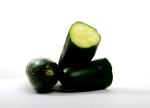“Extension on the Go” podcast by Debbie Johnson. Episode 101: Cucumbers
COLUMBIA, Mo. – It’s one of the most popular crops in the home garden. It’s 95 percent water, low in calories and an excellent source of vitamin K. It’s been grown in space and a mile underground.
“The National Garden Bureau every year selects a vegetable, an annual and a perennial to encourage people to grow. They provide history and education,” said David Trinklein, horticultural specialist for University of Missouri Extension. “This year is the year of the cucumber.”
Choosing varieties
There are hundreds of varieties of cucumbers, but they all fall under one of two categories.
“There are two classes of cucumber: the slicing type and the pickling type,” Trinklein said. “Fact of life is you can slice and eat either one, and you can make pickles out of either one. It’s just most people prefer the slicing type for eating raw and the pickling type for making pickles.”
There are other choices to make when selecting varieties. Cucumbers contain varying degrees of organic compounds called cucurbitacins, which are similar to the compounds used to make turpentine. These compounds can give cucumbers a very bitter taste.
“It’s thought that this is a deterrent to keep herbivores from eating the fruit and the seeds,” Trinklein said. “Today’s cultivated cucumbers have been bred to eliminate these compounds, but occasionally, especially with heirloom plants, you can have cucumbers that are bitter.”
Cucumbers can also be the source of a faux pas. They contain a compound that, when it sits in your stomach long enough, causes you to burp, Trinklein said. Today, you can purchase burpless varieties.
Growing
Cucumbers are tender, warm-season plants and should not be planted or transplanted until all fear of frost has passed, Trinklein said. Even a slight frost will kill these sun-loving plants.
They do love full sun and well-drained soil, he said. Cucumbers are thirsty plants that do well with deep waterings rather than frequent sprinklings. Like most vining crops, cucumbers need to be fertilized carefully.
“If you put on too much nitrogenous fertilizer early in the life of the plant, you’ll get lush, lush vine growth and very poor flowering and fruiting,” Trinklein said. “Watch the nitrogen until you have fruit set, and then maybe add a little bit, but don’t overdo it.”
For the cucumber to produce fruit, sex matters. Cucumbers are monoecious, meaning both male and female flowers are produced on the same plant. Trinklein says people often contact him concerned that their cucumbers are flowering but producing no fruit.
“Nature values the female of the species more,” he said. “The cucumber will not put out a female flower until there are adequate male flowers to pollinate it. You can wait a lifetime and the male flowers, called staminates, will not produce fruit because they’re incapable of it.”
Beneficial and easy to grow, the cucumber is a worthy addition to any home garden. They also have an interesting physiology.
“Cucumbers can be as much as 20 degrees cooler inside than outside air,” Trinklein said. “Hence the expression cool as a cucumber.”
For information about when to plant cucumbers, go to extension.missouri.edu/p/G6201-14.
Learn about the history of cucumbers at ipm.missouri.edu/MEG/2014/3/Cucumber-A-Brief-History.
Cucumber slices
- The cucumber is native to India, where it has been grown for almost 3,000 years.
- Cucumbers came to England during the reign of Henry VIII when Catherine of Aragon demanded them for her Spanish salads.
- Columbus brought them to the New World.
- Seventeenth-century physicians prescribed placing patients with fevers on a bed of cucumber to cool them down
- Botanist John Gerard wrote in “The Herbal” (1597) that cucumbers eaten three times a day in oatmeal porridge would heal red noses and pimples of the face.
- Samuel Johnson so reviled cucumbers that he wrote, “They should be well sliced, dressed with pepper and vinegar and then thrown out…”
- Russian cosmonauts grew cucumbers on the Salyut 7 space station in 1982.
- Cucumbers were cultivated nearly one mile beneath the Earth’s surface in an Ontario nickel mine in 1984.
- The largest cucumber on record was grown in China. It was 67 inches long and weighed 154 pounds.
- Cucumbers are a member of the gourd family, along with melons, squash and pumpkins.
- Florida produces the most cucumbers in the United States.
Read more http://extension.missouri.edu/news/DisplayStory.aspx?N=2142





